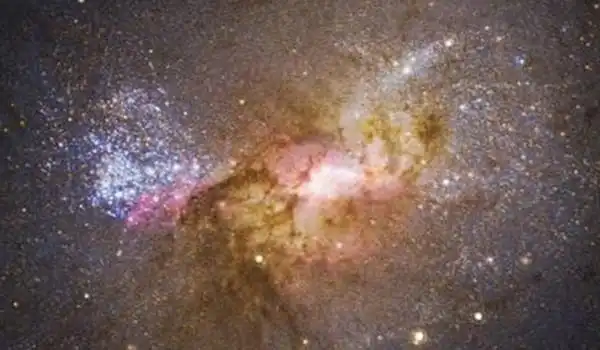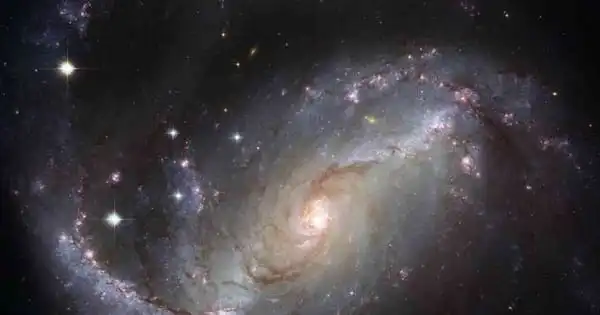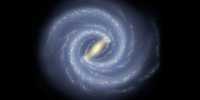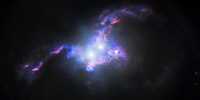Black holes, which are sometimes depicted as deadly creatures that enslave light, take on a less evil role in the latest Hubble Space Telescope research. A black hole in the dwarf galaxy Henize 2-10 is producing stars rather than devouring them. The black hole appears to be contributing to the galaxy’s inferno of new star creation. The dwarf galaxy is located in the southern constellation Pyxis, 30 million light-years away.
This little galaxy sparked a decade-long discussion among astronomers about whether dwarf galaxies harbored black holes equal to the supermassive behemoths observed in the centers of larger galaxies. Little Henize 2-10, which has one-tenth the number of stars contained in our Milky Way, is poised to play a significant role in resolving the enigma of where supermassive black holes originated in the first place.
The Hubble Space Telescope is a NASA-ESA international collaboration project (European Space Agency). The telescope is managed by NASA’s Goddard Space Flight Center in Greenbelt, Maryland. Hubble science operations are managed by the Space Telescope Science Institute (STScI) in Baltimore, Maryland. STScI is operated for NASA by the Association of Universities for Research in Astronomy in Washington, D.C.
“Ten years ago, as a graduate student thinking I’d spend my career on star formation, I looked at the data from Henize 2-10 and everything changed,” said Amy Reines, who published the first evidence for a black hole in the galaxy in 2011 and is the principal investigator on the new Hubble observations, which were published in the January 19 issue of Nature.
Hubble’s incredible resolution clearly reveals a corkscrew-like pattern in gas velocities, which we can match to the notion of a precessing, or wobbling, outflow from a black hole. That pattern would not be found in a supernova remnant, therefore it is practically our smoking gun confirmation that this is a black hole.
Amy Reines
“From the beginning, I felt something strange and exceptional was happening in Henize 2-10, and now Hubble has offered a very clear picture of the relationship between the black hole and a surrounding star-forming zone approximately 230 light-years from the black hole,” Reines said.
That link is a gas outflow spanning across space like an umbilical cord to a brilliant star nursery. When the low-velocity outflow came, the region already had a dense cocoon of gas. According to Hubble spectroscopy, the outflow was travelling at around 1 million miles per hour, striking into the dense gas and spreading out like a garden hose slamming into a pile of dirt. Hubble calculated the ages of newborn star clusters that dot the route of the outflow’s propagation.
This is the opposite effect found in larger galaxies, as material falling toward the black hole is swept away by surrounding magnetic fields, generating brilliant jets of plasma flying at near-light speed. Gas clouds caught in the path of the jets would be heated far beyond their ability to cool and create stars. However, with the less-massive black hole in Henize 2-10 and its softer outflow, gas was compressed just enough to initiate the birth of new stars.
“Henize 2-10 is only 30 million light-years distant, which is close enough for Hubble to clearly record both photos and spectroscopic evidence of a black hole outflow. The outflow, rather than limiting star formation, was actually driving the birth of new stars, which was a pleasant surprise “said Zachary Schutte, Reines’ graduate student and the study’s lead author.

Reines has suspected that the peculiar radio and X-ray emissions in Henize 2-10 were caused by a big black hole, but not one as massive as those detected in larger galaxies. Other astronomers, on the other hand, believed that the radiation was most likely being emitted by a supernova remnant, which would be a common occurrence in a galaxy that is rapidly producing enormous stars that explode.
“Hubble’s incredible resolution clearly reveals a corkscrew-like pattern in gas velocities, which we can match to the notion of a precessing, or wobbling, outflow from a black hole. That pattern would not be found in a supernova remnant, therefore it is practically our smoking gun confirmation that this is a black hole” Reines stated.
Reines anticipates that more research will be directed on dwarf galaxy black holes in the future, with the goal of using them as a clue to the puzzle of how supermassive black holes formed in the early universe. Astronomers have been puzzling over it for a long time. The link between the galaxy’s mass and its black hole can provide hints. The black hole in Henize 2-10 has a mass of about 1 million solar masses. Black holes in larger galaxies can be more than a billion times the mass of our Sun. The core black hole grows in size as the host galaxy grows in size.
Current theories on the origin of supermassive black holes break down into three categories: 1) they formed just like smaller stellar-mass black holes, from the implosion of stars, and somehow gathered enough material to grow supermassive, 2) special conditions in the early universe allowed for the formation of supermassive stars, which collapsed to form massive black hole “seeds” right off the bat, or 3) the seeds of future supermassive black holes were born in dense star clusters, where the cluster’s overall mass would have been enough to somehow create them from gravitational collapse.
So far, none of these black hole seeding ideas has emerged as the dominant one. Dwarf galaxies, such as Henize 2-10, provide promising prospective clues since they have remained small over cosmic time, rather than growing and merging like giant galaxies like the Milky Way. Astronomers believe that dwarf galaxy black holes could be analogs for black holes in the early universe, when they were just forming and growing.
“We haven’t been able to view the age of the first black holes, so the major question has become: where did they come from? Dwarf galaxies may preserve some recollection of the black hole seeding scenario that would otherwise be lost to time and space “Reines stated.















